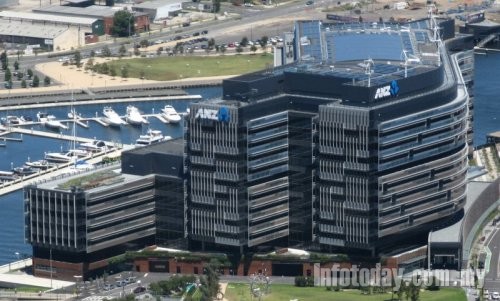Project: Environmentally friendly electrical installation
Online: www.evcco.com.au or www.my-greenproducts.com.my
Phone: 02 9651 4999 or malaysia Phone: 603-80237743/8743 Fax:603-80239743
The ANZ Bank’s new head office in Melbourne’s Docklands precinct is Australia’s largest single-tenant office building, providing 87,000 m2 of floor space that accommodates some 6500 staff.
The $620 million building, developed by Bovis Lend Lease, is one of the early adopters of the Evcco range of environmentally friendly halogen-free conduits. The conduits were selected because they contain no PVC or halogens, a criterion that was stipulated in the base building’s specification, issued by Bovis Lend Lease.
Commenting on the specification, Warren Coombes project manager for Maxim Electrical, the contracting firm that installed the electrical fitout for the base building, said: “The building’s tenant was aiming for the highest currently available environmental accreditations for both its base building, and for the building fitout, which will provide office accommodation, eateries, a gymnasium and childcare facilities for up to 6500 employees to support ANZ Bank’s global business.

“Bovis Lend Lease then built the office complex to the highest environmental standards to achieve a 5 Star environmental rating. The design specified ‘no PVC and no halogen content’. It called for only HFT (halogen-free, flame-resistant and temperature-stable) products, including the conduit that was buried in concrete and which will never see the light of day once it is poured.”
The Evcco conduits are constructed from a halogen-free, flame-retardant polymer that has been formulated as an alternative to PVC and contains no known toxins. As such, there is no PVC environmental issue arising from electrical conduit in this installation, because they don’t contain any environmental and safety hazards that can leach into soil or be released into the air by fire.
“The four grades of Evcco polymer conduits that were used throughout the structure are all lighter and easier to install than metal and PVC conduits,” continues Coombes. “Since the Evcco conduit weighs
“Such ease of use was a big factor in an installation that involved more than 25,000 lengths of conduit - more than 100,000 m all up - in diameters ranging from 20, 25, 32 to 40 mm.”
The four types of Australian-manufactured conduit were used to carry electrical cabling in surface and sub-surface applications. Other applications for the Evcco conduit included being used within safety equipment such as smoke-detecting aspiration systems and air-sampling systems for protection against toxicity.
The conduits - available with and without long-term UV protection - are complemented by a range of junction boxes, inspection elbows and tees, bends and adapters.
“While providing the required environmental benefits to the developer and tenant, the conduits are designed with installers in mind as well,” stated John McNab, Managing Director of Albatech, the manufacturer of Evcco conduits. “They can be installed to easily follow the contours of structures - unlike steel that has to be bent or welded into shape - while still maintaining their protective properties to the electrical cabling inside.
“The difficulty with metal pipes is that it has to be bent to conform to the building contours, which presents installation difficulties as well as OHS issues where personnel have to cope with the greater weight of the material being manoeuvred.”
McNab pointed out that the conduit was the result of an extensive research and development program into overcoming hurdles in producing flame-retardant pipe and conduit without degrading their overall performance. Issues addressed by the R&D included high electrical and di-electrical properties, impact and high-temperature resistance, low smoke density, minimal formation of flue gases in the event of a fire.
“What is particularly
